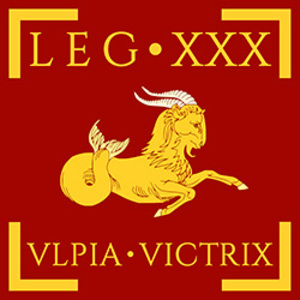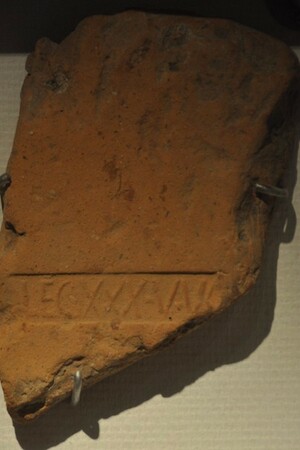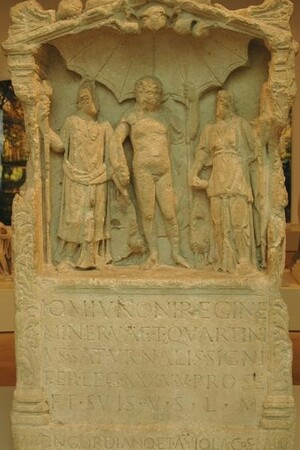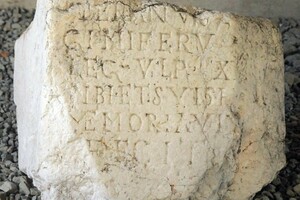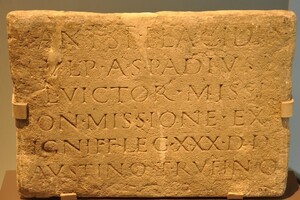Roman Legion - Legio XXX Ulpia Victrix
Legio XXX Ulpia Victrix ("The Thirtieth Victorious Legion of Trajan") was a legion created in 105 CE to participate in Emperor Trajan's Dacian Wars. The legion's name combines the emperor's family name, Ulpia, and the epithet Victrix, meaning "victorious." The legion was designated as the thirtieth because, at the time of its formation, there were 29 legions under Emperor Trajan's command.
Dates of existence: 105 CE - 5th century CE.
Legion Symbol: Neptune, later Jupiter. In the 3rd century, Capricorn was added.
Nicknames: Ulpia (Trajan's), Victrix (Victorious); Pia Fidelis ("faithful and loyal").
Military History
- The legion was formed in 105 CE for participation in the Dacian Wars (which took place from 101 to 102 and from 105 to 106 CE) by Emperor Trajan. Dacia (the Dacian Kingdom) was an ancient state that existed on the territories of modern-day Romania, Moldova, Ukraine, and part of modern-day Bulgaria.
- Legio XXX Ulpia Victrix was initially stationed at Brigetio (Szőny) in Upper Pannonia. Some soldiers from the legion participated in the Dacian Wars, and for their distinction, the legion earned the epithet Victrix ("Victorious"). Pannonia was a Roman province (from the 1st to 5th centuries CE), located in Central Europe on the territory of modern Hungary, eastern Austria, southwestern Slovakia, northern Slovenia, northern Croatia, northeastern Serbia, northern Bosnia and Herzegovina.
- From 118 to 122 CE, Legio XXX Ulpia Victrix likely stayed near the Dacian border to quell disturbances that arose after the death of Emperor Trajan. At this time, the legion was commanded by Legate Quintus Marcius Turbo Fronto, a close friend of Emperor Hadrian (who reigned from 117 to 138 CE).
- In 122 CE, the legion was relocated to Castra Vetera (now the city of Xanten, Germany) in Lower Germany. The legion remained stationed there until its disbandment in 407 CE. The civilian settlement that grew around the legion's military base was named Tricensimae, meaning "thirtieth." Legionaries of Legio XXX Ulpia Victrix often carried out their tasks alongside soldiers from Legio I Minervia and even shared a camp with them in the city of Bonn (modern-day Bonn, Germany). Additionally, several detachments of the legion were stationed in Rigomagus (modern-day Remagen, Germany).
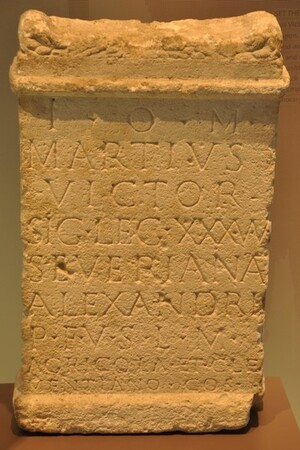 Altar dedicated to Jupiter by Legio XXX Ulpia Victrix. Stored in the Xanten Museum, Germany. 230 CE.
Altar dedicated to Jupiter by Legio XXX Ulpia Victrix. Stored in the Xanten Museum, Germany. 230 CE.
- Inscriptions from the region near the Dutch river indicate that they sometimes collaborated on construction projects and many inscriptions simply refer to the "Army of Lower Germany" (exercitus Germaniae Inferioris, often abbreviated as EXGERINF).
- As there were few military actions in the province of Lower Germany in the late 2nd and early 3rd centuries CE, vexillations of Legio XXX Ulpia Victrix were frequently sent to other provinces, including Gaul, Mauretania, Parthia, and others.
- In the civil war of 193 CE (the Year of the Five Emperors), Legio XXX Ulpia Victrix supported Lucius Septimius Severus, who, after his victory, granted the legion the title Pia Fidelis ("faithful and loyal"). Many inscriptions of soldiers from this legion have been found in various parts of Gaul.
 Denarius of Roman Emperor Lucius Septimius Severus, minted in 193 CE in honor of the 30th Ulpian Legion.
Denarius of Roman Emperor Lucius Septimius Severus, minted in 193 CE in honor of the 30th Ulpian Legion.
- Legio XXX Ulpia Victrix participated under the leadership of Emperor Marcus Aurelius Severus Alexander in his campaign in 235 CE against the Sassanids.
- Legio XXX Ulpia Victrix took part in Alexander Severus's campaign on the Rhine frontier in 235 CE.
- Later, tensions on the Rhine frontier escalated, and the legion played an active role in the military events of the 240s-250s CE.
- Legio XXX Ulpia Victrix participated in Emperor Gallienus's campaign against the Franks in the 250s CE in Gaul.
- In 260 CE, the Franks repeated their raid on the province but were defeated by General Postumus. Marcus Cassianius Latinius Postumus was a Roman general of Batavian origin, whom the Roman army, after defeating the Franks, declared emperor around 260 CE, despite their oath to Emperor Gallienus. He ruled as emperor in Gaul, Germany, and Spain, and founded the Gallic Empire. Later, his own soldiers killed him in 269 CE.
- Legio XXX Ulpia Victrix supported the usurper Postumus. From 260 to 274 CE, the legion was under the command of the emperors of the Gallic Empire.
- In 274 CE, Emperor Aurelian (reigned 270-275 CE) brought Gaul back under Roman control. Xanten became the northernmost Roman garrison, guarded by Legio XXX Ulpia Victrix.
- The last records of the legion date back to the early 5th century when it was still stationed at its old camp in the city of Xanten. The legion likely ceased to exist in 407 CE, when the Rhine frontier collapsed. The legion is mentioned in the Notitia Dignitatum in the list of legions of Gaul.
Related topics
List of Roman Legions, Legion, Legionnaire, Marcus Ulpius Nerva Trajan, Trajan's Column, The Trophy of Trajan, Legio I Minervia
Literature
- R. Kanya " Legion”
- Yann Le Bohec, "Legio XXX Vlpia", in: Yann Le Bohec, Les legions de Rome sous le Haut-Empire (2000, Lyon) 71-74.
- Bennett, Julian (2008). Legio XXX Ulpia Victrix Pia Fidelis and Severus ' expeditions to Asia and Mesopotamia. Romano-Germanic Central Museum.
- Hebblewhite, Mark (2016-12-19). The Emperors and the Armies in the Late Roman Empire, 235-395 AD. Taylor and Frances.
- Geza Alfeldi, Konsulat und Senatorenstand under der Antoninen (Bonn: Rudolf Habelt Verlag, 1977)
- Paul MM Leunissen, Konsuln und Konsulare in der Zeit von Commodus bis Severus Alexander (Amsterdam: JC Gieben, 1989).
